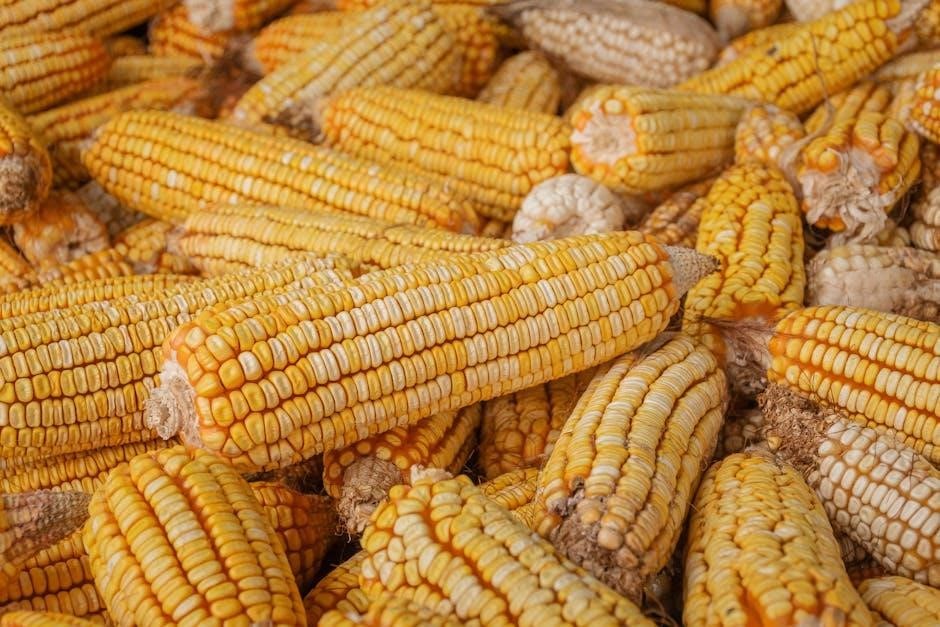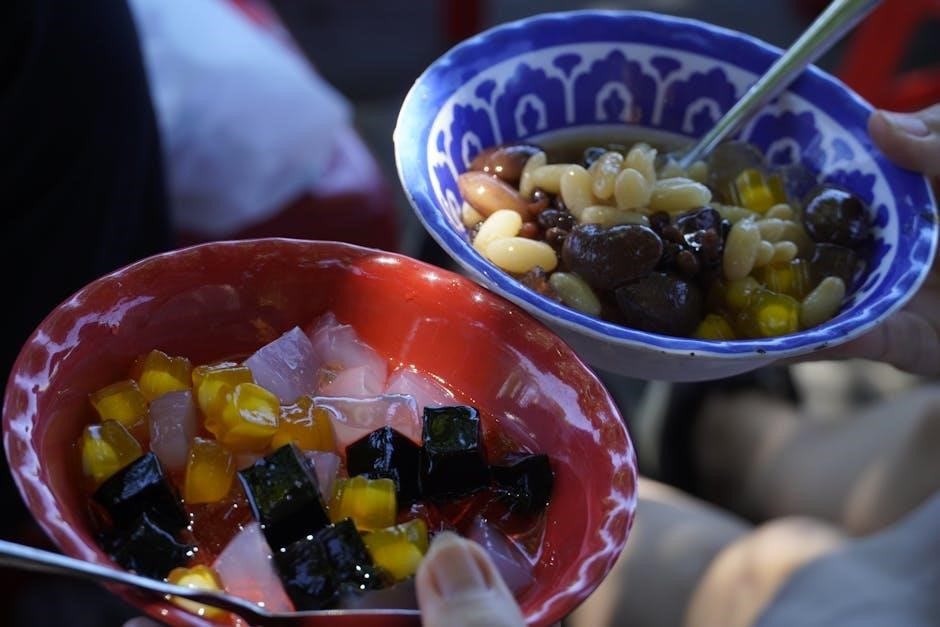Corn Toss, also known as Cornhole, is a popular outdoor game involving tossing bean bags onto a wooden board with a hole․ It’s easy to learn, fun, and perfect for gatherings, promoting friendly competition and relaxation․
Overview of Corn Toss
Corn Toss, or Cornhole, is a classic outdoor game where players toss bean bags onto a wooden board with a central hole․ The objective is to land bags on the board or through the hole to score points․ It’s a simple yet engaging activity ideal for backyard gatherings, tailgating, or beach trips․ Players take turns throwing from a distance, and scoring is based on where the bags land․ This game is enjoyed by people of all ages and skill levels, making it a popular choice for casual and competitive play alike․
History and Popularity of Corn Toss
Corn Toss, also known as Cornhole, has its roots in traditional American games․ Its origins are traced back to the Midwest, where it gained popularity as a casual, social activity․ Over time, the game spread across the country, becoming a staple at tailgating events, barbecues, and outdoor parties․ Its simplicity and accessibility have made it a beloved game for people of all ages․ Today, Corn Toss is not only a backyard favorite but also a competitive sport, with organized leagues and tournaments drawing enthusiasts nationwide․

Materials Required for Corn Toss
Corn Toss requires two wooden boards with holes, eight bean bags (four of each color), and a flat playing area․ The boards are typically 2×4 feet with a 6-inch hole centered 9 inches from the top․
Corn Toss Boards
Corn Toss boards are essential for the game, typically made of wood and measuring 2×4 feet․ Each board features a 6-inch hole centered 9 inches from the top edge․ The surface is smooth, allowing bean bags to slide easily․ Boards are placed 27 feet apart for official play, though distances can vary for casual games․ They can be customized with paint or wraps for personalization․ DIY options are popular, with plans available online for building at home․ Durable construction ensures longevity, making them suitable for outdoor use and transportation to events or gatherings․
Bean Bags
Bean bags, also known as cornhole bags, are crucial for gameplay․ Made from durable fabric like canvas or polyester, they’re filled with dried beans or corn, weighing around 14-16 ounces․ Each bag measures 6×6 inches, designed for easy tossing․ Bags come in various colors and patterns, often matching team preferences․ They’re stitched securely to ensure filling stays inside․ Proper weight and size ensure consistent throws, while the fabric allows for a smooth slide on the board․ High-quality bags are essential for long-lasting gameplay and fair competition․
Playing Area
The playing area for Corn Toss requires a flat, level surface, such as a lawn, driveway, or beach․ Official games place the boards 27 feet apart, front edge to front edge, though shorter distances are common for casual play․ Ensure the space is clear of obstacles to allow safe tossing and movement․ The surface should be firm to prevent the boards from shifting during gameplay․ Ideal locations include open outdoor spaces where players can toss comfortably without interference․ Proper setup ensures a fair and enjoyable game for all participants․

Setting Up the Game
Setting up Corn Toss involves placing boards on a flat surface, ensuring they are level and 27 feet apart․ Secure the boards to prevent movement during play and verify the playing area is clear of obstructions․ Proper setup ensures fair and safe gameplay for all participants․
Choosing a Location
Choosing a suitable location for Corn Toss is crucial for an enjoyable experience․ Opt for a flat, level surface such as a lawn, parking lot, or beach․ Ensure the area is clear of obstacles to avoid interference․ The playing field should be large enough to accommodate the 27-foot distance between the boards, as per official rules․ However, this distance can be adjusted for casual games or younger players․ The boards should face each other directly, with the holes aligned․ Proper lighting is essential, especially for evening games․ A well-chosen location enhances gameplay and safety, ensuring a fun experience for all participants․

Placing the Boards
Placing the Corn Toss boards correctly is essential for fair and enjoyable gameplay․ Position the boards 27 feet apart from front edge to front edge, following official regulations․ For casual games, this distance can be reduced, especially for younger players or those with mobility challenges․ Ensure the boards are aligned directly across from each other, with the holes facing forward․ Use a measuring tape to verify the distance and ensure accuracy․ The surface should be flat and level to prevent any tilt, promoting consistent gameplay․ Proper placement ensures a balanced and fun experience for all participants, adhering to the game’s standards․
Ensuring the Boards Are Level
Ensuring the Corn Toss boards are level is crucial for fair and consistent gameplay․ Begin by placing the boards on a flat surface and using a carpenter’s level to check for evenness․ If the surface is uneven, use shims or sand to stabilize the boards․ Adjust the legs of the boards as needed to achieve a perfectly level surface․ Once leveled, double-check the alignment to ensure the holes are aligned directly across from each other․ A level board ensures accurate throws and prevents any unfair advantage, making the game enjoyable for all players․ Proper leveling is essential for maintaining the integrity of the game․

Understanding the Rules and Scoring

Corn Toss scoring involves 3 points for bags through the hole and 1 point for bags on the board․ Points are tallied after each round, with teams aiming to reach 21 points to win․ The game is played in innings, with players alternating throws, and the score difference determines the winner․ Proper scoring ensures fair and competitive gameplay for all participants involved, making it a fun and engaging outdoor activity for everyone․
Scoring Points
Scoring in Corn Toss is straightforward and exciting․ A bag that goes through the hole earns 3 points, while one that lands on the board scores 1 point․ The scoring is cumulative, with points tallied after each round․ The goal is to reach a total of 21 points to win the game․ Points are awarded based on the bag’s final position, ensuring fair and competitive gameplay․ This system makes every throw count and keeps players engaged as they strategize to outscore their opponents․ Proper scoring ensures a fun and balanced experience for everyone involved․
Rules of the Game
Corn Toss is a turn-based game where players or teams alternate throws․ Each game is divided into innings, with each player tossing four bags per inning․ The goal is to be the first to score 21 points or more by the end of an inning․ A coin toss decides who starts․ Players alternate turns, ensuring fair play․ Proper foot placement behind the foul line is required․ This structured approach ensures fair and competitive gameplay, making Corn Toss enjoyable for all participants in various settings․
Canceling Points
In Corn Toss, if both players or teams score the same number of points in an inning, their points cancel out, resulting in no score for that inning․ This rule ensures competitive balance and fairness․ For example, if one player scores three points and the other also scores three points, neither gains an advantage․ Additionally, bags that fall off the board or do not land on the playing surface do not count toward the score․ This cancellation rule adds strategic depth to the game, as players must aim for higher scores to outpace their opponents effectively․
Foul Lines and Foot Placement
In Corn Toss, players must stand behind the foul line when throwing․ The official foul line is 27 feet from the front edge of the board for adults․ For kids, seniors, or those with physical impairments, the distance can be reduced․ Both feet must remain behind the foul line until the bag is released․ If a player steps over the line during a throw, it is considered a foul, and the throw does not count․ Proper foot placement is essential to ensure fair play and maintain the integrity of the game․ Adhering to these rules guarantees a fun and competitive experience for everyone involved․
Gameplay Instructions
Players take turns tossing bean bags at the board, aiming to score points by landing bags on the board or through the hole․ The goal is to reach 21 points first․
Starting the Game
To begin, position the Corn Toss boards 27 feet apart for adults or a shorter distance for younger players․ Ensure the playing surface is flat and clear․ Decide who starts by flipping a coin․ Players take turns tossing bean bags, aiming for the board or the hole․ Each toss must be made from behind the foul line․ The objective is to score points by landing bags on the board or through the hole, with the goal of reaching 21 points first․ Safety and fair play are essential for an enjoyable game․
Throwing the Bags
Players must stand behind the foul line when tossing․ Grip the bean bag firmly, ensuring control․ Aim for the board or the hole, using an underhand throw․ Release the bag with a smooth motion, avoiding spin to maintain accuracy․ Ensure the bag lands flat on the board or passes cleanly through the hole․ Players alternate turns, with each tossing one bag per round․ Proper foot placement and throwing technique are crucial for consistency and safety․ Always check the surface for obstacles before throwing to prevent accidents and ensure fair play․
Winning the Game
To win at Corn Toss, a player or team must reach exactly 21 points before their opponent․ Points are earned by getting bags through the hole (3 points) or landing them on the board (1 point)․ The game concludes when one side achieves 21 points at the end of an inning․ If both players or teams score, their points cancel out․ The winner is the first to reach 21 without being matched in the same round․ Skill and strategy are key to securing victory, as precise throws and clever scoring can make all the difference․
Strategies and Tips
Master a consistent stance, grip, and throwing motion for accuracy․ Aim for the hole but strategic bag placement on the board can also secure points․ Practice regularly․
Mastering Your Stance
Standing comfortably with feet shoulder-width apart is crucial for balance․ Keep your dominant foot forward and body slightly bent․ A stable stance ensures consistent throws․ Align your eyes with the target hole to maintain focus․ Avoid shifting weight excessively, as it disrupts accuracy․ Practice different stances to find what works best for you․ A solid foundation improves control and precision, helping you land the bag where you aim․ Adjustments can be made based on personal preference or physical comfort․
Gripping the Bag
Gripping the bean bag correctly enhances control and accuracy․ The basic grip involves placing all fingers across the bottom seam․ The pinch grip, using the thumb and index finger, suits lighter throws․ The handshake grip, with the bag resting in the palm, offers more power․ Experiment with different grips to find comfort and consistency․ A secure grip prevents slipping during the toss, ensuring better aim and distance․ Proper grip technique is essential for mastering the throw and achieving optimal results in the game․ Adjust grips based on personal preference or throwing style for the best performance․
Throwing Techniques
Mastering the underhand toss is key to success in Corn Toss․ Players should grip the bag firmly and swing their arm forward, releasing the bag with a smooth motion․ Aiming for the hole or the board’s surface requires precision․ Techniques vary, with some favoring a soft, high arc for distance control, while others use a quicker, lower release for accuracy․ Practicing different throws, such as sliding or lobbing, helps adapt to varying distances and conditions․ Proper foot placement and body alignment ensure a balanced, consistent throw․ Refining your technique improves scoring and overall performance in the game․

Variations of Corn Toss
Corn Toss offers various fun twists, such as kids’ versions with smaller boards, party games for larger groups, and themed editions for special events․
- Kids’ Version: Uses smaller boards and shorter distances for younger players․
- Party Games: Includes team-based or timed challenges for lively gatherings․
- Themed Editions: Custom designs like holiday or sports-themed boards for unique experiences․
Kids’ Version
The Kids’ Version of Corn Toss is designed to be fun and accessible for younger players․ Boards are smaller and lighter, making them easier to handle․ The throwing distance is reduced, typically between 10-15 feet, to accommodate smaller arms and developing skills․ This version often includes colorful designs and themes to engage children․ It’s a great way to introduce kids to the game, promoting physical activity and coordination․ Parents can adjust rules further, such as allowing multiple tries or team play, to ensure everyone enjoys the game․ It’s perfect for family gatherings or school events, fostering teamwork and joy․
Party Games
Corn Toss is a fantastic addition to any party, offering a fun and competitive activity for guests․ Its simplicity makes it accessible to all ages, fostering social interaction and laughter․ For larger gatherings, multiple boards can be set up to accommodate more players․ Themed versions, such as glow-in-the-dark bags or custom-designed boards, can add a unique twist․ The game’s portability and ease of setup make it ideal for outdoor events, tailgating, or beach parties․ It’s a versatile activity that encourages teamwork and friendly rivalry, ensuring everyone has a memorable time․

DIY Corn Toss
Crafting your own Corn Toss game is straightforward with basic tools like a drill and jigsaw․ Use plywood for the boards and fabric for the bags․
Building the Boards
Constructing Corn Toss boards is a simple DIY project requiring basic tools․ Use 2×4 lumber for the frame and 1/2-inch plywood for the surface․ Cut the plywood to 2×4 feet, then attach it to the frame․ Drill a 6-inch diameter hole centered 9 inches from the top and 12 inches from the sides․ Sand the edges for safety and ensure the board is sturdy․ Paint or finish the boards for durability and style․ Properly angling the boards is essential for gameplay, with the front edge elevated 2-3 inches higher than the back․
Making the Bean Bags
Bean bags are crafted from durable fabric, typically 6×6 inches․ Use materials like duck canvas or heavy-duty cotton for longevity․ Fill each bag with 1-2 pounds of dried beans or corn for the right weight․ Sew the bags securely, ensuring the filling stays inside․ Reinforce stitches for durability, especially around the edges․ Use contrasting colors or patterns to differentiate teams․ Ensure each bag meets regulation weight and size for fair gameplay․ Properly made bags are essential for consistent and enjoyable play, making them a crucial component of the Corn Toss experience․

Safety Considerations
Ensure the playing area is clear of obstacles and tripping hazards․ Supervise children during play and avoid throwing bags with excessive force to prevent injuries or damage․
Playing Safely
Ensure the playing area is clear of obstacles and tripping hazards․ Players should wear proper footwear and avoid slippery surfaces․ Always handle the bean bags gently to prevent accidental throws․ Supervise children during play to teach them proper throwing techniques and safety․ Avoid overexertion when tossing the bags, as this can lead to injuries․ Keep a safe distance from the boards to prevent collisions․ Be mindful of bystanders and ensure they are out of the throwing area․ Regularly inspect the boards and bags for damage to maintain a safe gaming environment․ Safety precautions help prevent injuries and ensure an enjoyable experience for everyone․
Avoiding Injuries
To prevent injuries while playing Corn Toss, ensure proper warm-up before starting․ Use correct throwing techniques to avoid straining muscles․ Wear non-slip footwear and avoid playing on uneven surfaces․ Keep children supervised to prevent accidental collisions․ Inspect the bean bags and boards for damage before use․ Avoid overexertion when tossing the bags, as this can lead to shoulder or back strain․ Ensure players maintain a safe distance from each other during throws․ Regularly check the playing area for hazards and keep it well-lit․ By following these precautions, you can minimize risks and enjoy a safe, injury-free game․

Maintenance Tips
Regularly clean and wax the boards to protect the wood․ Store bean bags in a dry place to prevent mold․ Inspect for damage before use to ensure longevity․
Caring for the Boards
Regular maintenance ensures your corn toss boards remain durable and functional․ Clean the surface with a mild detergent and water, avoiding harsh chemicals․ Apply a wood sealant or wax to protect the finish and maintain a smooth tossing surface․ Store the boards in a dry, shaded area to prevent warping or fading․ Avoid exposing them to extreme temperatures or moisture․ Inspect the boards before each use for damage or wear, and make repairs promptly to ensure optimal gameplay and longevity․
Storing the Bags
Proper storage of bean bags is essential to maintain their quality and longevity․ Store them in a clean, dry, and cool place, away from direct sunlight and moisture․ Use a breathable container or bag to prevent mold and mildew․ Keep the bags organized to avoid tangling or creasing․ Clean the bags before storage to remove dirt or debris․ Avoid folding or compressing them tightly, as this may cause damage․ Regularly inspect the bags for wear and tear, and repair any holes or frayed edges before storing․ This ensures they remain in good condition for future games․
Corn Toss is a timeless and versatile game that brings people together, offering fun and excitement for all ages․ With simple rules and minimal equipment, it’s perfect for backyard gatherings, tailgating, or beach trips․ By following the setup, scoring, and safety guidelines, you can ensure enjoyable and competitive games․ Whether you’re a casual player or a seasoned pro, Corn Toss promises endless entertainment․ Its ease of play and social nature make it a standout choice for any outdoor event, fostering camaraderie and lasting memories for everyone involved․
